If you are someone who has already had a WooCommerce store, finds that it can no longer meet your requirements, and think about Shopify as your next destination, this article has got you. And “How to migrate from WooCommerce to Shopify?” is definitely your concern right now!
Migrate from WooCommerce to Shopify can be a very complicated procedure as these two have completely different database structures. Worry not! In this article, we will be presenting to you 6 key steps for migrating from WooCommerce to Shopify:
- 💡 Step 1: Backup database of WooCommerce store
- 💡 Step 2: Set up a new Shopify store
- 💡 Step 3: Set up Source and Target Cart
- 💡 Step 4: Select entities to migrate
- 💡 Step 5: Perform full migration from WooCommerce to Shopify
- 💡 Step 6: Follow go-live checklist for Shopify stores
Now, let's dive into each step to see what you have to do!
Migrate from WooCommerce to Shopify: Preparation
To help you better visualize the whole Shopify migration process, we summarized all the steps you need to take and put them into this migration guide flow chart.
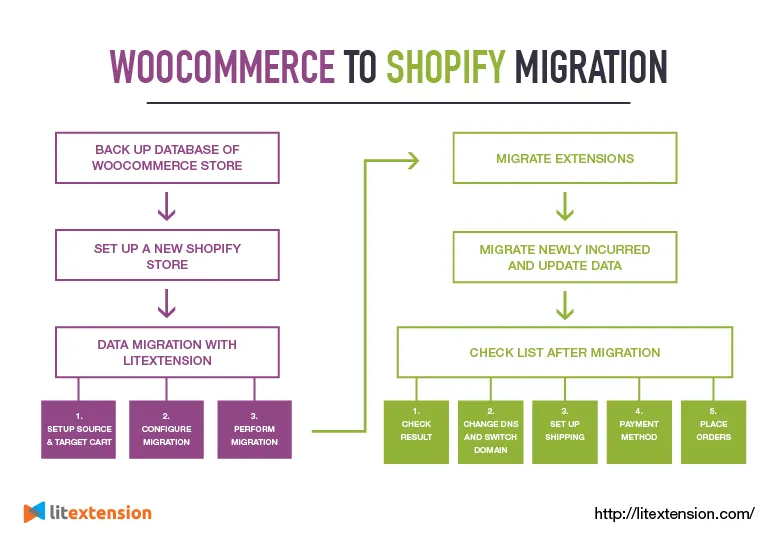
By following these steps, as illustrated above, you can transfer all your data from WooCommerce to Shopify seamlessly and accurately with LitExtension.
1. Backup database of WooCommerce store
When transferring your data with LitExtension, you don't have to worry about data distortions because we will not alter anything on your WordPress WooCommerce Source Store. Thus, it is unnecessary to back up your WooCommerce source store data before migration.
In case you still want to backup your data, here is how to do it:
- Go to your WooCommerce store back-end, and navigate to Tools > Export.
- From there, you can export your site content, such as your posts, pages, comments, custom fields, etc. to XML files. If you, on the other hand, don’t want to export all of your content, you can just choose the specific fields you want to export.
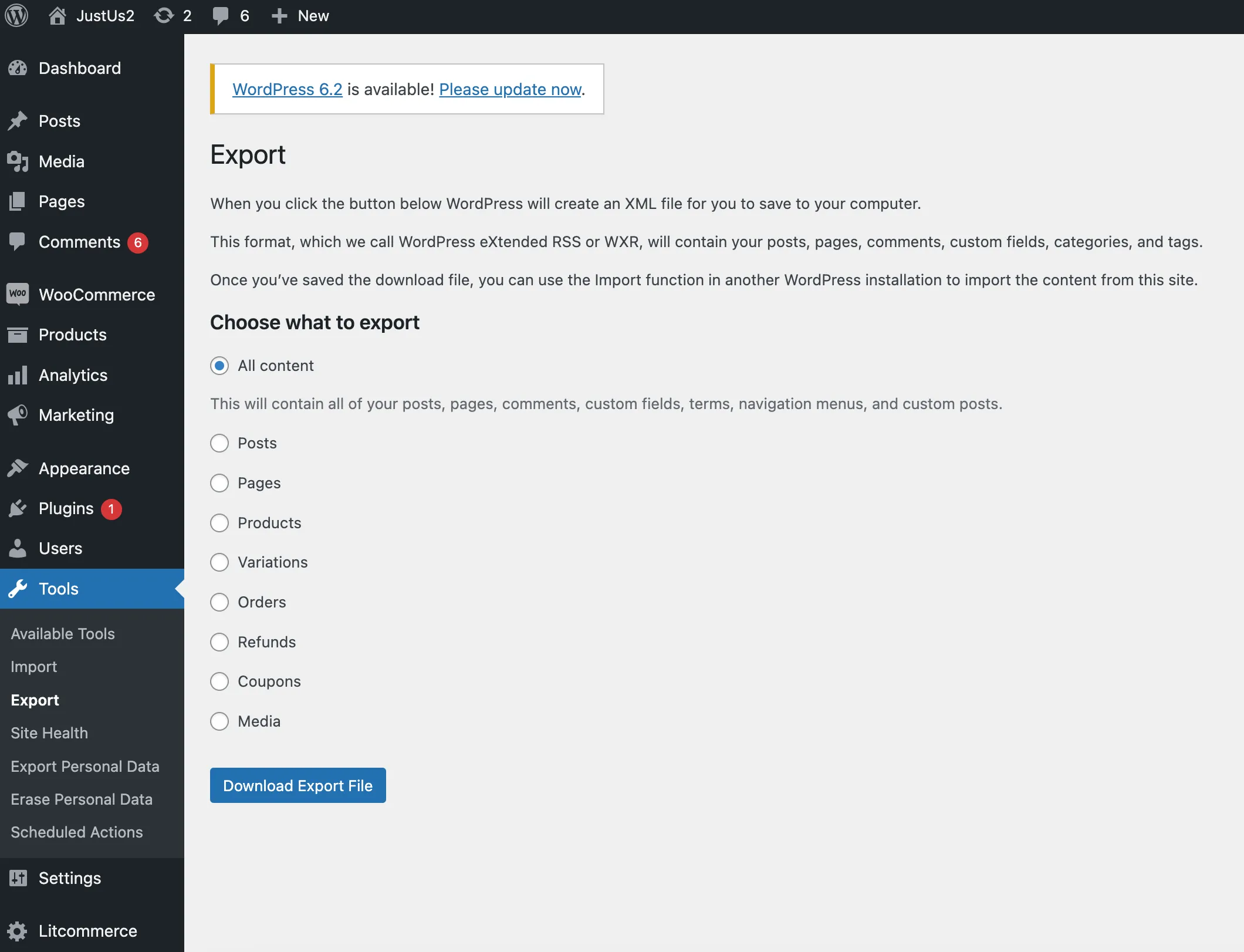
- Hit “Download Export File” to get XML files.
This default function will compress your data to XML files. If you want to do more, for example, exporting products with images, some WooCommerce plugins (free and paid versions) will help you deal with that.
2. Set up a new Shopify store
After successfully backing up your files, it’s time to create a new Shopify home and begin your migration!
- The first step is to sign up for a Shopify account. As of the writing, Shopify offers a 3-day free trial, and you can extend it for three more months with just 1$ each!
- After that, Shopify may ask you for information about your new store, or you can skip all the questions and start your journey on Shopify.
- Now, you're on the Shopify dashboard and can get down to migrating from WooCommerce to Shopify.
How to Migrate WooCommerce to Shopify with LitExtension in 3 steps?
An automated migration service is optimal for migrating WooCommerce to Shopify right now. As the leading company in data migration with 12+ years of helping businesses, LitExtension has about 99% of customer satisfaction on Trustpilot.
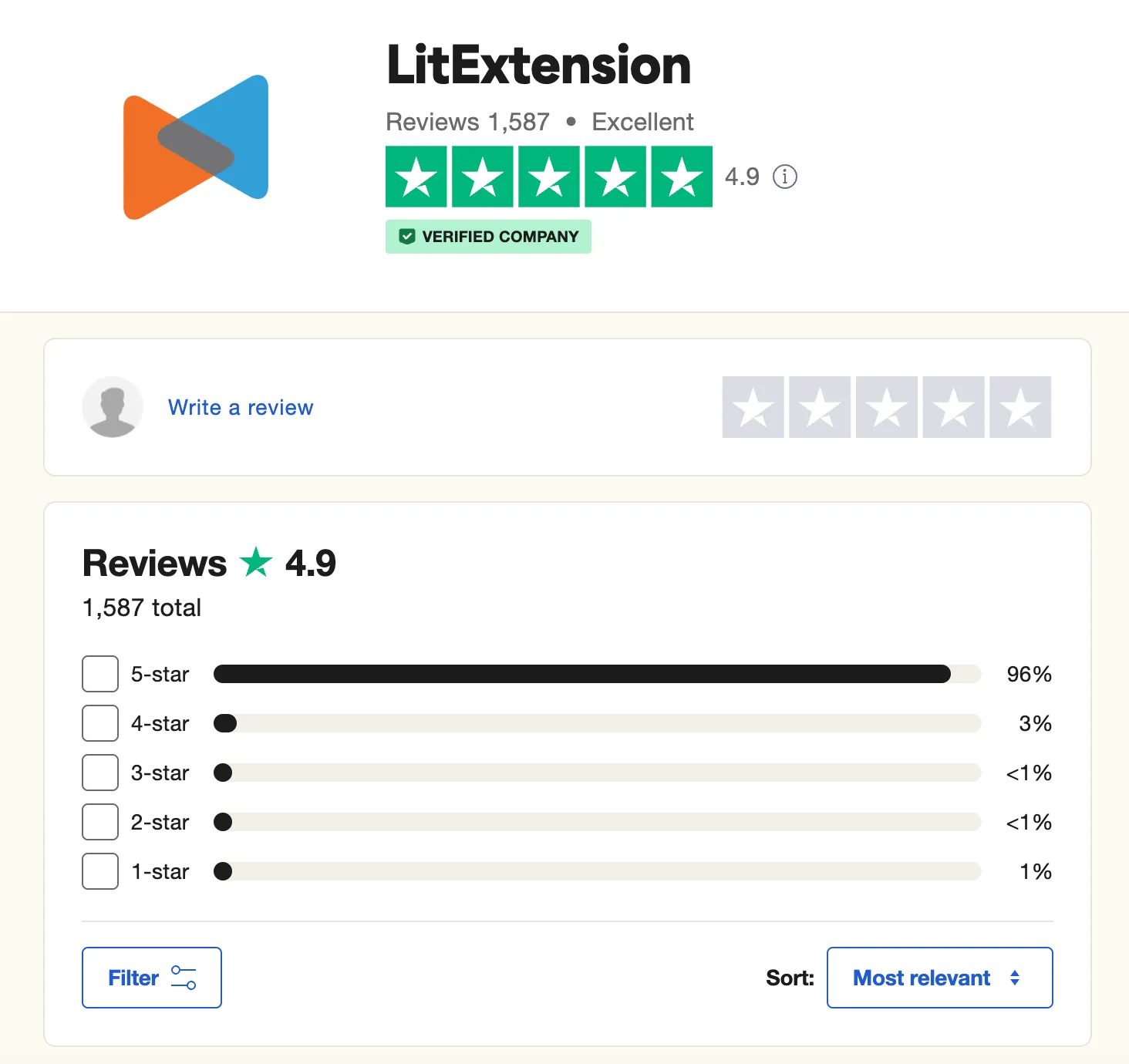
We will automatically, accurately, and safely migrate all your data from WooCommerce WordPress to Shopify. The migration process involves only 3 simple steps, and no technical skill is required.
To better understand our service, you can check out our WooCommerce migration to Shopify tutorial video.
Let me walk you through a step-by-step guide to migrating from WooCommerce to Shopify with LitExtension.
But first, you should register an account via the LitExtension if you haven’t had one. You may quickly log in using your Facebook or Google account.

Step 1: Set up Source and Target Cart
Once logged in to the LitExtension site, click “Create new migration” to move from WooCommerce to Shopify. Then, you can enter your Source's and Target Cart's information.
First, choose WooCommerce as your Source Cart from the drop-down menu. Then enter your store URL.
- Follow this instruction to download & set up the “le_connector” file. This connector has only one function, which is to create a bridge between your WooCommerce database with LitExtension.
- Then, you can extract the LitExtension zip file and upload the Connector folder to the root folder of WooCommerce. Once finished, a notification will appear on your screen “Connection was successfully installed“.

Next, moving on to Target Cart setup.
- After you have chosen Shopify as your Target Cart from the menu, enter your store URL and the API password into the blank space.
- Regarding Shopify API, LitExtension will migrate your data using API. If you're using LitExtension on Shopify App Store, the Shopify API is automatically connected.
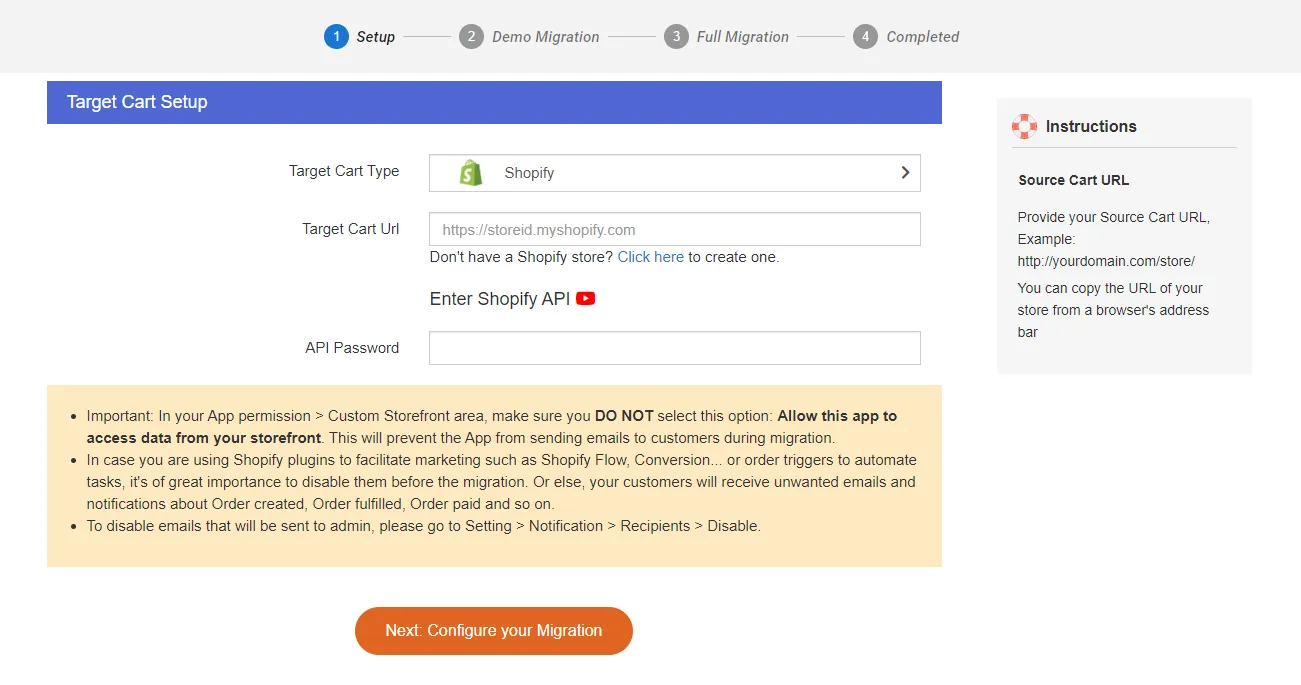
If you're not getting the idea of how to get an API password from your Shopify store, please refer to the below video.
After finishing the cart setup, click “Next” to the following stage of the migration.
Step 2: Select entities to migrate
Now, you choose the entities to migrate WooCommerce to Shopify.
In this case, we support migrating products, customers, pages, blog posts, and coupons. You can choose to migrate only a few, for example, only import products from WooCommerce to Shopify or click “Select all” to migrate all of them.

Please note that if you want to transfer customers and orders from WooCommerce to Shopify, you'll need to be in the Shopify Grow pricing plan or higher. Or else, please use our CSV File Migration service instead to have these entities transferred accurately and seamlessly.
On top of that, to help you extend your WooCommerce to Shopify migration possibilities, we also offer some Additional Options, such as:
1. Clear current data on Target Store before Migration
If you choose this option, all data on your Target Store before the migration process (if any) will be deleted. Therefore, the data duplication risk when moving from WooCommerce to Shopify can be avoided.
2. Create the 301 redirects on your Target Store after migration
301 redirect is a procedure of pointing URLs from one site to another. In other words, when your customers click on your old WooCommerce website links, they will be redirected immediately to the corresponding page on your new Shopify store.

Don't forget to map your order status and language so that your data can appear appropriately on your Shopify source store.
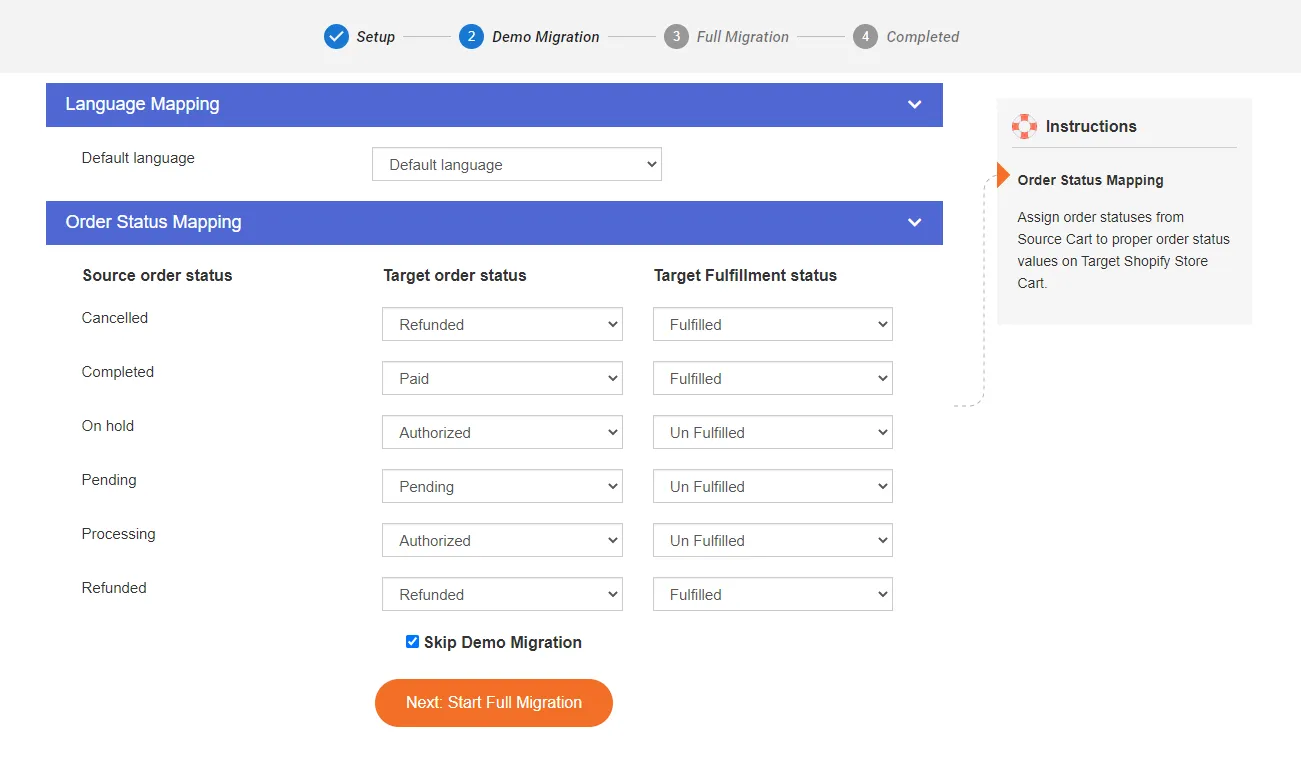
Step 3: Perform full migration from WooCommerce to Shopify
Now you are switching from WooCommerce to Shopify. We highly recommend you run the demo migration first to see how LitExtension will carry out the migration process (learn more about LitExtension demo migration).
Or, you can skip the Demo migration and run the full migration!
Once the migration begins, it will proceed smoothly on the server. As a result, you don't have to keep your PC running while the data is transferred. It is entirely safe to turn it off!
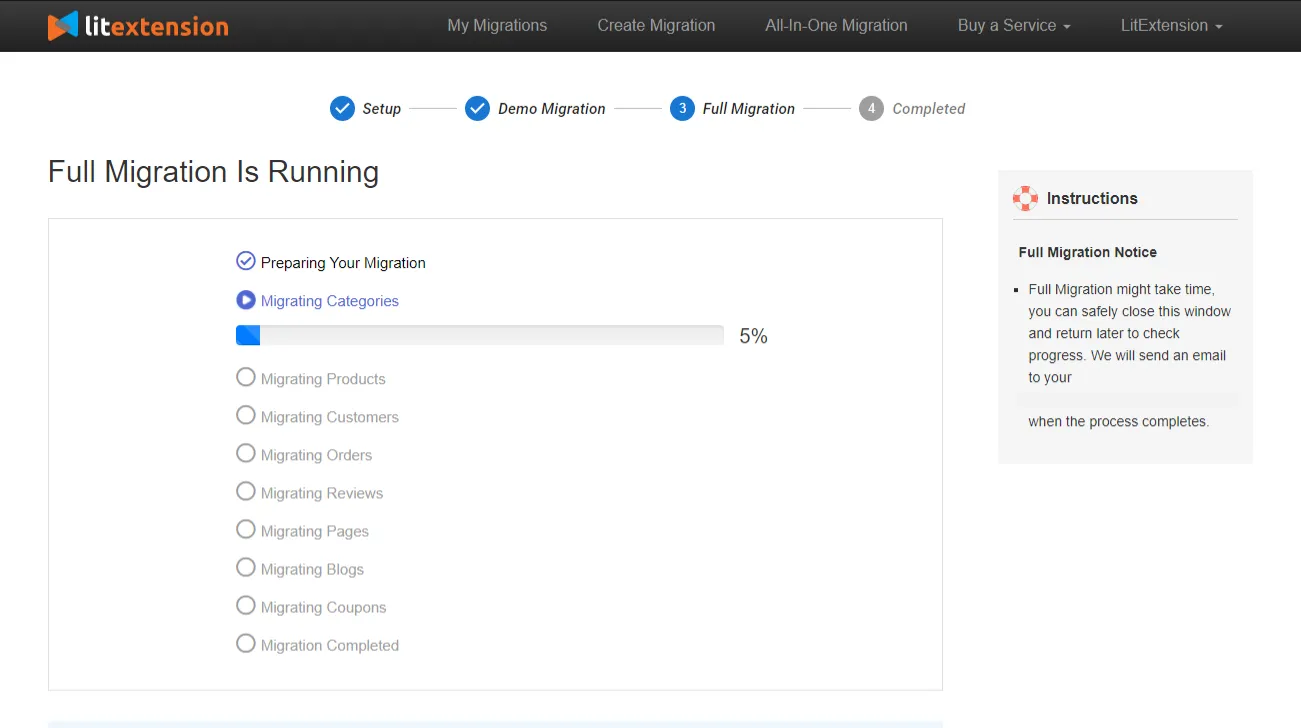
You will be notified through email when the WooCommerce to Shopify migration process is complete.

You may have some extensions installed on your WooCommerce site to support your business, and you don’t want to lose these extended functionalities. To do this, look for and install Shopify apps with purposes that are related to those of your WooCommerce store (you can refer to our list of best Shopify apps).
Due to the peculiarity of Shopify apps and WooCommerce plugins, LitExtension will examine whether we can assist you in migrating your data to the new apps you choose. If feasible, we will facilitate the migration of data from your WooCommerce plugins to the corresponding apps in Shopify. It's important to note that this additional service may incur extra costs.
During the whole migration process, LitExtension still keeps your old WooCommerce store running normally. Accordingly, you will still receive new orders and customers as usual while decorating your new Shopify store.
That is how our further migration services come in handy!
- Recent Data Migration allows you to import all newly appearing entities to Shopify.
- Smart Update updates changes you have made to data in the old store, along with all the newly appearing entities.
- Re-migration service enables you to migrate your data all over again.
All these three options are FREE if you have performed full migration with LitExtension within 3 months before and the total number of additional entities is less than 10% of the total entities in the first migration.
WooCommerce to Shopify Migration: Post Migration
After the migration, you might want to take some extra steps to set up your new Shopify store. Here is a list of some post-migration activities that we recommend.
- Check migration result
- Change DNS and switch domain
- Set up your shipping
- Choose the payment method
- Try placing some orders
Want to Migrate Your Store from WooCommerce to Shopify?
LitExtension Automated Migration Tool transfers products, customers, and orders
from WooCommerce to Shopify—fast, accurate, and hassle-free.

Methods to Migrate from WooCommerce to Shopify
There're 3 main methods to migrate from WooCommerce to Shopify:
- Transfer data manually
- Hire a migration expert
- Choose a migration service like LitExtension
Let's together analyze the advantages and disadvantages of each method for migrating from WooCommerce to Shopify:
1. Transfer data manually
First is the manual data transfer, the method you may get in your mind. With this method, you can transfer your data manually via Shopify CSV import files. So what to consider?
Pros:
- Manually moving your data does not involve additional expenses for hiring experts or migration services.
- During the migration process, nobody can access your data except for you. Thus, your data will be completely secure.
Cons:
- Manually transferring data can be a time-consuming task with a large number of entities.
- You need to be familiar with WooCommerce and Shopify for smooth data transfer.
2. Hire a migration expert
With this method, you can browse in Shopify Experts to find a migration expert to move your store data to Shopify. Here are some main points you may need to consider:
Pros:
- Migration experts have experience and expertise in handling complex data transfers, reducing the chances of errors and data loss.
- You can fully focus on other aspects like marketing and branding of your business.
Cons:
- Hiring a migration expert can be costly, particularly if you have substantial data to transfer to Shopify. Currently, if you hire a Shopify expert, he/she may charge you $50 to $150 per hour.
3. Choose a migration service like LitExtension
At LitExtension, we offer a seamless automated migration process without manual effort. When you connect the LitExtension connector to your WooCommerce store, it will work like a bridge to transfer data to Shopify, and we will not access your data on your store. We ensure the accuracy and integrity of your data during the transfer and support.

With LitExtension, you can significantly speed up the migration process, especially for large amounts of data. What is more, all the migration costs will be transparent to you.
The best method for you depends on your budget, technical expertise, time availability, and specific requirements. However, a migration service can offer more efficiency and ensure data integrity for larger stores with complex data structures.
Besides WooCommerce to Shopify migration, we also have other Shopify migration that you might find interesting:
- How to Migrate from Wix to Shopify in 6 Steps
- How to Migrate PrestaShop to Shopify in 3 Steps
- Migrate Squarespace to Shopify: Benefits & Guideline
- Lightspeed to Shopify: How to Migrate with Ease
- Ecwid To Shopify Migration: Everything You Need to Know
WooCommerce vs Shopify – All Pros & Cons Analyzed
Both Shopify and WooCommerce are powerful for eCommerce.
- Shopify is a powerful eCommerce platform powering more than 4 million stores worldwide.
- WooCommerce is a WordPress plugin with eCommerce functions with more than 6 million users.
Before heading down WooCommere and Shopify comparison and analysis, please note that we do not earn any commission for the review; the table below is compiled by the LitExtension testing team and collected from what our customers think about these two platforms.
Platform | Features | Rating | Overall Score |
 |
| Ease of use eCommerce features Marketing features SEO features Apps & Extensions | 4.5/5 |
 |
| Ease of use eCommerce features Marketing features SEO features Apps & Extensions | 4.3/5 |
Or do you want a non-written resource? Our video on WooCommerce vs Shopify below can solve your concern!
So, if you meet the same problems that Shopify can solve, then Shopify is truly your next destination!
Benefits When Migrating WooCommerce to Shopify
So now, you may share the same question with our customers (who did migrate from WooCommerce to Shopify) in mind: “What’s exactly the benefits when migrating from WooCommerce to Shopify?”.
We have 5 answers to your question:
- Shopify is a fully hosted platform, meaning you don't have to worry about managing web hosting or server maintenance.
- Shopify has a simple and user-friendly interface. As a result, you can quickly manage and configure your store without extensive technical knowledge.
- You can enjoy “peace of mind” when Shopify handles all the security of your online store security measures with SSL certificates, data backups, and security patches.
- Shopify is mobile-responsive. With a Shopify theme, your store looks great and functions seamlessly on all devices, including smartphones and tablets.
- Shopify provides built-in inventory management features. This eliminates the need to rely heavily on third-party plugins or extensions, providing a more streamlined and integrated experience.
⭐️ What do customers think when migrating from WooCommerce to Shopify with LitExtension?
“Fast, friendly, knowledgeable and top-notch service”
I cannot recommend LitExtension enough – Jay was a delight to work with, nothing was too much trouble and they were incredibly responsive to any emails!
With a relatively complex WooCommerce to Shopify migration (~80k orders) and a few additional fields that we only realised later down the line, they dealt with everything promptly with great professionalism.
Would not hesitate in recommending them to anyone who has a complex migration from one platform to another.
– James Harland from the United Kingdom via Trustpilot
Want to Migrate Your Store and Grow on Shopify
Having decided that WooCommerce is no longer the perfect fit? Transfer all your data to Shopify now and enjoy its powerful eCommerce functions, extensive App Store, and stunning website templates that can bring your business to the next level.
What Entities Can Be Migrated from WooCommerce to Shopify
If you choose to migrate your store from WooCommerce to Shopify, below is what you can migrate:
Data entity | Detail |
Products | - Name, SKU, Full Description, Status, Manufacturer. - Meta Title, Meta Description. - Additional Images. - Price, Special Price. - Variants: (SKU, Weight, Quantity, Price, Special Price). - Manage Stock. |
Product Categories | - Name, Description. - Meta Title, Meta Description. - Image. |
Manufacturers | - Name. |
Customers | - First Name, Last Name, Email. - Shipping Address: (Company, Address 1, Address 2, Country, State, City, Zip Code, First Name, Last Name). - Billing Address: (Company, Address 1, Address 2, Country, State, City, Zip Code, Telephone, First Name, Last Name). - Address: (Street Address, Zip Code, City, State, Country, First Name, Last Name). |
Orders | - Order Date, Order Status, Order Products: (Name, SKU, Option), Product Price, Quantity, Discount Price, Tax Price, Total Price, Order Comments Shipping Price, Shipping Price. - Shipping Address: (Company, Address 1, Address 2, Country, State, City, Zip Code, First Name , Last Name). - Customer Name, Email, Billing Address: (Company, Address 1, Address 2, Country, State, City, Zip Code, Telephone, First Name, Last Name). |
Coupons | - Coupon Code, Coupon Date, Coupon Expire Date. |
Reviews | - Created Date, Rate, Comment. |
Cms Pages | - Title, Description. |
Blogs | - Title, Full Description. |
How LitExtension Troubleshoot WooCommerce to Shopify Migration
Potential issues may arise during the migration process, and here are LitExtension solutions to these.
1. Data mapping and compatibility
- Problem: Data from WooCommerce may not have a direct equivalent in Shopify
- Solution: You will have a consultation with LitExtension support team if you encounter any compatibility issues before migration to minimize all the upcoming issues.
2. Custom functionality and plugins
- Problem: WooCommerce may have custom functionality or plugins that don't have direct equivalents in Shopify.
- Solution: We can assist in identifying the custom functionality or plugins in WooCommerce and explore Shopify's app store for alternatives.
3. Design and theme migration
- Problem: WooCommerce themes may not be compatible or transferrable to Shopify.
- Solution: LitExtension experts can select and recommend a new Shopify theme for you. If you want to customize a new theme that fits the look and feel of your old store, we can assist you with our Shopify Development Services.
4. Product variants and attributes
- Problem: WooCommerce and Shopify may have different ways of managing product variants and attributes, leading to potential discrepancies.
- Solution: With LitExtension Additional Option, you may “Migrate Source Store categories into Shopify Smart Collections”. You can find out more here.
5. SEO and URL redirection
- Problem: Changing platforms may result in different URL structures, potentially impacting SEO and causing broken links.
- Solution: LitExtension Additional Option can support you with proper URL redirection from old WooCommerce URLs to corresponding Shopify URLs. Please refer to this document for more insights.
6. Downtime and impact on live store
- Problem: The migration process may require temporary downtime, impacting your live store's availability.
- Solution: LitExtension ensures that your store will run smoothly during the migration and receive new orders. There will be downtime when transferring the domain, but it will not take long.
With LitExtension, you can minimize and simplify the migration process!
Migrate WooCommerce to Shopify – FAQs
Can I convert WooCommerce to Shopify?
Of course, you can convert/ migrate WooCommerce to Shopify.
Is it easy to migrate from WooCommerce to Shopify? At first, it might seem daunting to migrate from WooCommerce to Shopify, but it is actually very easy to handle with only 3-simple-step migrations by LitExtension:
- Set up Source and Target Cart
- Select entities to migrate
- Perform demo/full migration from WooCommerce to Shopify
Why migrate from WooCommerce to Shopify?
Moving from WooCommerce to Shopify may derive from many factors. Based on our customers who move from WooCommerce to Shopify, there’re 3 main reasons:
- WooCommerce requires a manual update as the peculiarities of an open-source eCommerce platform.
- WooCommerce is rather difficult to use and set up.
- The additional cost (hosting, themes, or plugins) is way too high.
We've got you with this ultimate WooCommerce vs Shopify comparison for all features.
Can I migrate WordPress to Shopify?
Yes, you can migrate from WordPress to Shopify with LitExtension.
Can I integrate Shopify with WooCommerce?
Of course, you can integrate Shopify with WooCommerce with the help of LitCommerce - a multichannel selling service!
Can I migrate WooCommerce to Shopify Plus?
Yes! LitExtension supports the migration from WooCommerce to Shopify Plus. You can choose to only migrate products from WooCommerce to Shopify Plus or many other data like orders, customers, and coupons.
What are the benefits of moving from WooCommerce to Shopify?
If you meet these below signs, here is what you can get when you transfer WooCommerce to Shopify.
1. You want a more user-friendly interface with less code required. Shopify will provide a more user-friendly and intuitive interface than WooCommerce, making it easier for non-technical users to manage and customize their online store.
2. You find yourself busy handling security and updates on WooCommerce. As the nature of the hosted solution, Shopify will handle everything, so you can fully focus on scaling up your business with marketing and promotion.
3. If mobile shopping is vital to your business, migrating to Shopify can enhance the mobile experience for your customers. Shopify strongly focuses on mobile commerce, offering responsive themes. You also have an app that allows you to manage your Shopify store on the go.
4. You want full-fledged support. If you prefer a platform with readily available resources and assistance, migrating to Shopify can be advantageous. Shopify has a robust support system with extensive documentation, a vibrant community, and dedicated customer support.
WooCommerce Shopify Migration – Recap
Let's have a quick takeaway of what we've gone through in this WordPress WooCommerce Shopify migration article!
We presented to you 6 quick and easy steps to migrate from WooCommerce to Shopify at ease:
-
- Backup database of WooCommerce store – prevent any issues that may arise in the migration process.
- Set up a new Shopify store – get a new one for receiving WooCommerce data.
- Set up Source and Target Cart – install LitExtension connector to WooCommerce store root folder & provide Shopify API password.
- Select entities to migrate – select some or all data to migrate.
- Migrate from WooCommerce to Shopify | Full migration – see how our service works & run the full migration.
- Follow go-live checklist for Shopify stores – get ready to sell online on Shopify!
If you are a store owner and have been looking for a solution to migrate from WooCommerce to Shopify or any other platform to Shopify, don’t hesitate to contact our support team via live chat to get advice.
Final Words
We hope this write-up has helped you explore everything on how to switch from WooCommerce to Shopify with LitExtension.
At LitExtension, we guarantee accuracy and the highest level of security to your data with a 30-day money-back guarantee and dedicated support.
Let's visit LitExtension blog and join our eCommerce community to get more knowledge.
Good luck with your migration to Shopify!

